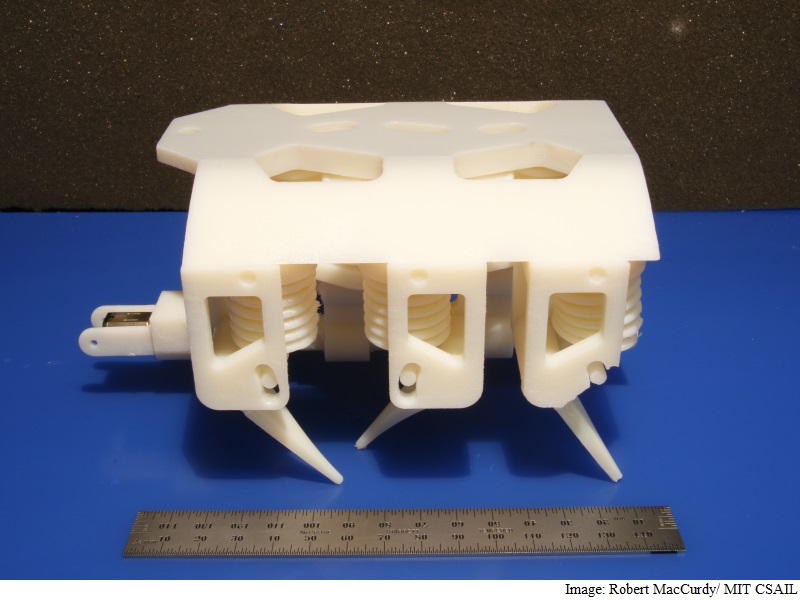- Home
- Science
- Science News
- First 3D Printed Robots Made Out of Both Solids and Liquids
First 3D-Printed Robots Made Out of Both Solids and Liquids

The new method allows the team to automatically 3D print dynamic robots in a single step, with no assembly required, using a commercially-available 3D printer.
"Our approach, which we call 'printable hydraulics,' is a step towards the rapid fabrication of functional machines," said Daniela Rus, from Massachusetts Institute of Technology (MIT) in US.
"All you have to do is stick in a battery and motor, and you have a robot that can practically walk right out of the printer," said Rus.
Researchers 3D printed a tiny six-legged robot that can crawl via 12 hydraulic pumps embedded within its body.
Printing liquids is a messy process, which means that most approaches require an additional post-printing step such as melting it away or having a human manually scrape it clean.
That step makes it hard for liquid-based methods to be employed for factory-scale manufacturing.
With "printable hydraulics," an inkjet printer deposits individual droplets of material that are each 20 to 30 microns in diameter, or less than half the width of a human hair.
The printer proceeds layer-by-layer from the bottom up. For each layer, the printer deposits different materials in different parts, and then uses high-intensity UV light to solidify all of the materials except the liquids.
The printer uses multiple materials, though at a more basic level each layer consists of a "photopolymer," which is a solid, and "a non-curing material," which is a liquid.
"Inkjet printing lets us have eight different print-heads deposit different materials adjacent to one another, all at the same time," said Robert MacCurdy from MIT.
"It gives us very fine control of material placement, which is what allows us to print complex, pre-filled fluidic channels," he said.
Another challenge with 3D printing liquids is that they often interfere with the droplets that are supposed to solidify.
To handle that issue, the team printed dozens of test geometries with different orientations to determine the proper resolutions for printing solids and liquids together.
MacCurdy said that printing both liquids and solids is even more difficult with other 3D printing methods, such as fused-deposition modelling and laser-sintering.
The researchers 3D printed a small hexapod robot that weighs about 1.5 pounds and is less than 6 inches long.
To move, a single DC motor spins a crankshaft that pumps fluid to the robot's legs. Aside from its motor and power supply, every component is printed in a single step with no assembly required.
Among the robot's key parts are several set of "bellows" that are 3D printed directly into its body. To propel the robot, the bellows uses fluid pressure that is then translated into a mechanical force.
Get your daily dose of tech news, reviews, and insights, in under 80 characters on Gadgets 360 Turbo. Connect with fellow tech lovers on our Forum. Follow us on X, Facebook, WhatsApp, Threads and Google News for instant updates. Catch all the action on our YouTube channel.
Related Stories
- Samsung Galaxy Unpacked 2025
- ChatGPT
- Redmi Note 14 Pro+
- iPhone 16
- Apple Vision Pro
- Oneplus 12
- OnePlus Nord CE 3 Lite 5G
- iPhone 13
- Xiaomi 14 Pro
- Oppo Find N3
- Tecno Spark Go (2023)
- Realme V30
- Best Phones Under 25000
- Samsung Galaxy S24 Series
- Cryptocurrency
- iQoo 12
- Samsung Galaxy S24 Ultra
- Giottus
- Samsung Galaxy Z Flip 5
- Apple 'Scary Fast'
- Housefull 5
- GoPro Hero 12 Black Review
- Invincible Season 2
- JioGlass
- HD Ready TV
- Laptop Under 50000
- Smartwatch Under 10000
- Latest Mobile Phones
- Compare Phones
- Realme Narzo 90x 5G
- Realme Narzo 90 5G
- Vivo S50 Pro Mini
- Vivo S50
- OPPO Reno 15c
- Redmi Note 15 5G
- Redmi Note 15 Pro 5G
- Redmi Note 15 Pro+ 5G
- Asus ProArt P16
- MacBook Pro 14-inch (M5, 2025)
- OnePlus Pad Go 2
- Poco Pad M1
- Just Corseca Skywatch Pro
- Honor Watch X5
- Acerpure Nitro Z Series 100-inch QLED TV
- Samsung 43 Inch LED Ultra HD (4K) Smart TV (UA43UE81AFULXL)
- Asus ROG Ally
- Nintendo Switch Lite
- Haier 1.6 Ton 5 Star Inverter Split AC (HSU19G-MZAID5BN-INV)
- Haier 1.6 Ton 5 Star Inverter Split AC (HSU19G-MZAIM5BN-INV)
















